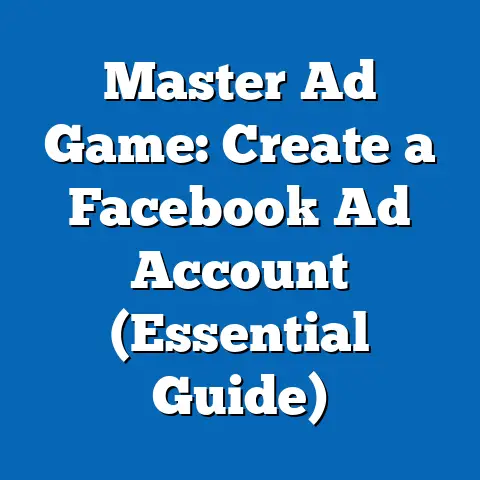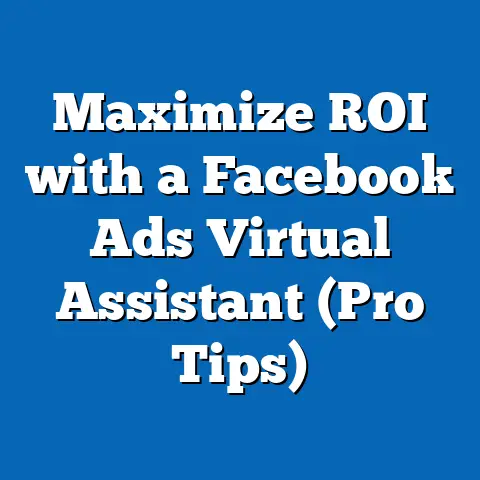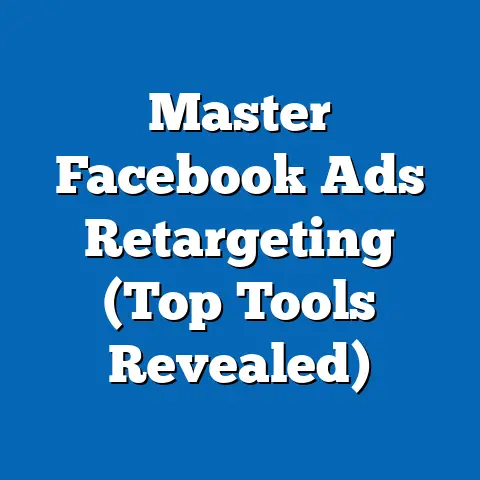Boost New Restaurant Success (Proven fb ad Strategies)
The aroma of freshly baked bread, the sizzle of grilling meats, the clinking of glasses – launching a new restaurant is a symphony of sensory experiences. But in today’s crowded culinary landscape, even the most exquisite symphony can be drowned out by the noise. I’ve seen it time and again: passionate chefs and dedicated owners pouring their hearts and souls into a new venture, only to find themselves struggling to fill seats in those crucial first few weeks. It’s a tough reality, and that’s where the power of Facebook advertising comes in.
I remember consulting with a small Italian bistro that had just opened its doors. Their food was fantastic, their ambiance charming, but no one knew they existed! After implementing a targeted Facebook ad strategy, we saw a dramatic increase in foot traffic, online orders, and ultimately, a thriving business. This isn’t just luck; it’s a testament to the power of reaching the right people, with the right message, at the right time.
This article will guide you through the proven strategies to leverage Facebook ads to not only boost visibility for your new restaurant but also drive foot traffic and build a loyal customer base. We’ll explore everything from identifying your target audience to crafting compelling ad content and analyzing campaign performance. So, let’s dive in and turn those empty tables into a bustling hub of happy diners!
Understanding the Power of Facebook Ads
In today’s digital age, if your restaurant isn’t on Facebook, it’s practically invisible. Facebook isn’t just a social media platform; it’s a powerful marketing tool with the potential to connect your restaurant with thousands of potential customers in your local area.
- The Numbers Speak for Themselves: Over 2.9 billion people use Facebook every month. That’s a massive audience! But more importantly, Facebook boasts incredibly granular targeting capabilities, allowing you to reach specific demographics, interests, and even behaviors. Studies show that Facebook ads can have a significant impact on brand awareness and sales, especially for local businesses.
- Local is Key: For a new restaurant, local reach is paramount. Facebook’s location-based targeting allows you to pinpoint potential customers within a specific radius of your restaurant. You can target people who live, work, or are just visiting the area, ensuring your ads are seen by those most likely to become patrons.
- Visual Appeal: The food industry thrives on visual appeal, and Facebook provides the perfect platform to showcase your culinary creations. Enticing images and videos of your dishes, your restaurant’s ambiance, and even happy customers can capture attention and drive cravings.
Takeaway: Facebook ads offer unparalleled reach and targeting capabilities, making them an essential tool for new restaurants looking to build awareness and attract customers. By leveraging the platform’s visual nature and local targeting options, you can effectively showcase your restaurant to the right audience.
Identifying Your Target Audience
Imagine throwing a fishing net into the ocean without knowing what kind of fish you’re trying to catch. You might catch something, but it’s unlikely to be what you’re hoping for. The same principle applies to Facebook advertising. Before you even think about creating an ad, you need to define your target audience. Who are you trying to reach? What are their preferences? Where do they hang out (both online and offline)?
- Defining Your Ideal Customer Profile: Start by creating a detailed profile of your ideal customer. Consider factors like age, gender, location, income level, interests, and dining habits. Are you targeting young professionals looking for a trendy brunch spot? Families seeking a casual dinner option? Or perhaps foodies eager to try the latest culinary innovation?
- Leveraging Facebook’s Audience Insights: Facebook’s Audience Insights tool is a goldmine of information. It allows you to gather data on the demographics, interests, and behaviors of people who are already connected to your Facebook page, as well as those who are interested in similar restaurants or cuisines. Use this tool to identify trends and patterns that can inform your targeting strategy.
- Creating Customer Personas: Take your ideal customer profile a step further by creating detailed customer personas. Give them names, backstories, and motivations. This will help you humanize your target audience and create ads that truly resonate with them.
Example: Let’s say you’re opening a vegan restaurant. Your target audience might include:
- Sarah, the Health-Conscious Millennial: Sarah is a 28-year-old yoga enthusiast who follows several vegan influencers on Instagram. She’s always looking for healthy and sustainable dining options.
- David, the Environmentally Aware Student: David is a 22-year-old college student who cares about animal welfare and reducing his carbon footprint. He’s on a tight budget but willing to spend a little extra for ethical food choices.
- Maria, the Experienced Vegan: Maria is a 45-year-old who has been vegan for several years. She’s knowledgeable about vegan cuisine and appreciates restaurants that offer creative and flavorful dishes.
By understanding these personas, you can tailor your ad copy, visuals, and targeting to appeal to their specific needs and interests.
Takeaway: Defining your target audience is crucial for effective Facebook advertising. By creating detailed customer profiles and leveraging Facebook’s Audience Insights tool, you can ensure your ads are seen by the people who are most likely to become your customers.
Crafting Compelling Ad Content
Now that you know who you’re trying to reach, it’s time to create ad content that will grab their attention and entice them to visit your restaurant. This is where creativity and compelling storytelling come into play.
- The Power of a Strong Hook: Your ad copy needs to immediately capture the reader’s attention. Start with a question, a surprising statistic, or a tantalizing description of your food. For example: “Tired of the same old pizza? Try our wood-fired Neapolitan pizzas, made with fresh, locally sourced ingredients!”
- Highlighting Your Value Proposition: What makes your restaurant unique? What do you offer that your competitors don’t? Emphasize your value proposition in your ad copy. Are you known for your farm-to-table cuisine? Your cozy ambiance? Your extensive wine list? Let people know what sets you apart.
- A Clear Call to Action: Tell people exactly what you want them to do. Use a clear and concise call to action, such as “Book a Table Now,” “Order Online,” or “View Our Menu.” Make it easy for them to take the next step.
- The Visual Feast: High-quality visuals are essential for restaurant ads. Invest in professional food photography and videography. Show off your most mouthwatering dishes, your inviting dining room, and your friendly staff.
- Storytelling Sells: Don’t just sell food; sell an experience. Share the story behind your restaurant. Talk about your passion for cooking, your commitment to quality ingredients, or your connection to the local community.
Example:
Ad Copy: “Escape the ordinary and indulge in authentic Italian flavors at [Restaurant Name]. Our wood-fired pizzas are made with fresh, locally sourced ingredients and baked to perfection in our traditional brick oven. Book a table now and experience the taste of Italy! #ItalianFood #Pizza #LocalRestaurant”
Visual: A stunning photo of a perfectly cooked pizza with melted mozzarella, fresh basil, and vibrant tomato sauce.
Takeaway: Compelling ad content is crucial for attracting attention and driving engagement. By crafting strong hooks, highlighting your value proposition, using clear calls to action, and showcasing high-quality visuals, you can create ads that entice potential customers to visit your restaurant.
Utilizing Facebook Ad Formats
Facebook offers a variety of ad formats, each with its own strengths and weaknesses. Choosing the right format can significantly impact the effectiveness of your campaign.
- Image Ads: Simple and straightforward, image ads are a great way to showcase a single dish or your restaurant’s ambiance. Use high-quality images that are visually appealing and relevant to your target audience.
- Video Ads: Video ads are incredibly engaging and can be used to tell your restaurant’s story, showcase your chefs in action, or provide a virtual tour of your dining room. Keep your videos short and sweet, focusing on the most important information.
- Carousel Ads: Carousel ads allow you to display multiple images or videos in a single ad. This is a great way to showcase a variety of menu items, highlight different aspects of your restaurant, or tell a more comprehensive story.
- Slideshow Ads: Slideshow ads are a cost-effective alternative to video ads. You can create a visually appealing slideshow using a series of static images.
- Collection Ads: Collection ads are designed for e-commerce but can be adapted for restaurants offering online ordering. They allow you to showcase a selection of menu items with direct links to your online ordering platform.
A/B Testing is Key: Don’t be afraid to experiment with different ad formats to see what works best for your restaurant. A/B testing allows you to compare the performance of different ads and identify the most effective strategies.
Example: A new burger joint could use a carousel ad to showcase its signature burgers, each with a mouthwatering photo and a brief description. A fine-dining restaurant could use a video ad to provide a virtual tour of its elegant dining room and highlight its sophisticated menu.
Takeaway: Facebook offers a variety of ad formats, each with its own strengths and weaknesses. By experimenting with different formats and A/B testing, you can identify the most effective strategies for promoting your restaurant.
Setting Your Budget and Bidding Strategy
Determining your Facebook ad budget can feel like a daunting task. How much should you spend? What’s a reasonable ROI? The answer depends on a variety of factors, including your marketing goals, target audience, and competition.
- Defining Your Marketing Goals: What are you hoping to achieve with your Facebook ads? Are you trying to increase brand awareness? Drive foot traffic? Generate online orders? Your marketing goals will influence your budget allocation.
- Considering Your Target Audience: The size and competitiveness of your target audience will also impact your budget. Reaching a larger, more competitive audience will typically require a higher budget.
- Competitive Analysis: Research what your competitors are spending on Facebook ads. This will give you a sense of the market and help you determine a competitive budget.
- Starting Small and Scaling Up: It’s often wise to start with a smaller budget and gradually scale up as you see positive results. This allows you to test different strategies and optimize your campaigns without breaking the bank.
- Understanding Bidding Strategies: Facebook offers a variety of bidding strategies, including:
- Lowest Cost: Facebook will try to get you the most results for your budget.
- Cost Per Result Goal: You set a target cost per result, and Facebook will try to achieve that goal.
- Value-Based Bidding: This strategy is best for businesses with a clear understanding of customer lifetime value.
- Lowest Cost: Facebook will try to get you the most results for your budget.
- Cost Per Result Goal: You set a target cost per result, and Facebook will try to achieve that goal.
- Value-Based Bidding: This strategy is best for businesses with a clear understanding of customer lifetime value.
Tracking and Adjusting: Regularly track your ad performance and adjust your budget accordingly. If you’re seeing positive results, consider increasing your budget. If your ads aren’t performing well, experiment with different targeting options, ad creatives, or bidding strategies.
Example: A new restaurant with a limited budget could start with a daily budget of \$20-\$30, targeting a small, highly localized audience. As they see positive results, they can gradually increase their budget and expand their targeting.
Takeaway: Setting an appropriate budget and choosing the right bidding strategy are crucial for maximizing your ROI. By defining your marketing goals, considering your target audience, and tracking your ad performance, you can optimize your spending and achieve your desired results.
Maximizing Engagement with Local Promotions
Local promotions are a powerful way to drive foot traffic and generate excitement for your new restaurant. Facebook offers a variety of tools to help you reach potential customers in your local area and promote your special offers.
- Location-Based Advertising: Facebook’s location-based advertising allows you to target potential customers within a specific radius of your restaurant. This is a great way to reach people who live, work, or are just visiting the area.
- Limited-Time Offers: Create a sense of urgency by offering limited-time discounts or promotions. For example: “Get 20% off your entire bill this weekend only!”
- First-Time Visitor Discounts: Encourage new customers to try your restaurant by offering a discount for first-time visitors.
- Event Marketing: Host events at your restaurant and promote them on Facebook. This could include live music, trivia nights, or special tasting menus.
- Partnering with Local Influencers: Collaborate with local food bloggers and influencers to promote your restaurant to their followers.
Example: A new coffee shop could offer a free pastry with the purchase of any coffee drink during its first week of operation. A Mexican restaurant could host a margarita Monday special, offering discounted margaritas all day long.
Takeaway: Local promotions are a great way to drive foot traffic and generate excitement for your new restaurant. By leveraging Facebook’s location-based advertising and partnering with local influencers, you can effectively reach potential customers in your area and promote your special offers.
Analyzing and Optimizing Campaign Performance
Running Facebook ads is not a “set it and forget it” process. It requires ongoing analysis and optimization to ensure you’re getting the best possible results.
- Key Metrics to Track: Pay attention to the following metrics:
- Reach: The number of unique people who saw your ad.
- Impressions: The number of times your ad was displayed.
- Click-Through Rate (CTR): The percentage of people who clicked on your ad.
- Cost Per Click (CPC): The average cost you paid for each click on your ad.
- Conversions: The number of people who took a desired action, such as booking a table or placing an order.
- Return on Ad Spend (ROAS): The amount of revenue generated for every dollar spent on advertising.
- Analyzing Ad Performance Data: Use Facebook Ads Manager to analyze your ad performance data. Identify which ads are performing well and which ones are not.
- A/B Testing: Continuously A/B test different aspects of your ads, such as your ad copy, visuals, targeting options, and bidding strategies.
- Optimizing Your Campaigns: Based on your analysis, make adjustments to your campaigns to improve their performance. This could include refining your targeting, updating your ad creatives, or adjusting your bidding strategy.
- Reach: The number of unique people who saw your ad.
- Impressions: The number of times your ad was displayed.
- Click-Through Rate (CTR): The percentage of people who clicked on your ad.
- Cost Per Click (CPC): The average cost you paid for each click on your ad.
- Conversions: The number of people who took a desired action, such as booking a table or placing an order.
- Return on Ad Spend (ROAS): The amount of revenue generated for every dollar spent on advertising.
Example: If you notice that your ad for a specific menu item is generating a high CTR but low conversions, you might consider improving the landing page or offering a discount to encourage people to place an order.
Takeaway: Analyzing and optimizing your campaign performance is crucial for maximizing your ROI. By tracking key metrics, A/B testing different strategies, and making data-driven adjustments, you can continuously improve your ad performance and achieve your desired results.
Conclusion
Launching a new restaurant is a challenging but rewarding endeavor. In today’s competitive culinary landscape, effective marketing is essential for success. Facebook ads offer a powerful and cost-effective way to reach potential customers, build awareness, and drive foot traffic.
By implementing the proven strategies discussed in this article, you can leverage the power of Facebook advertising to not only boost visibility but also drive foot traffic and build a loyal customer base. Remember to define your target audience, craft compelling ad content, utilize the right ad formats, set an appropriate budget, maximize engagement with local promotions, and continuously analyze and optimize your campaign performance.
I’ve seen firsthand how a well-executed Facebook ad strategy can transform a struggling new restaurant into a thriving local favorite. It takes dedication, creativity, and a willingness to experiment, but the results can be truly remarkable. So, embrace the power of Facebook advertising and watch your new restaurant flourish! With the right approach, you can overcome initial challenges and achieve lasting success in the competitive culinary landscape. Now, go out there and create some mouthwatering magic!






